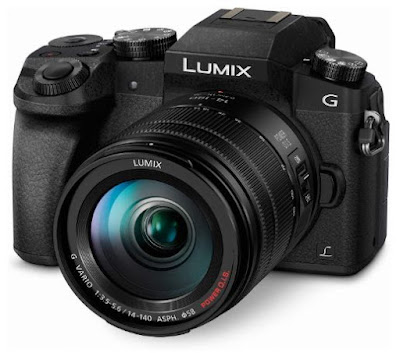Panasonic Lumix G7 Mirrorless Review User Manual
Panasonic Lumix G7 Review with Manuals pdf - Which segment does the LUMIX G7 actually enter? What is certain is that it is a mirrorless camera, with a Micro Four Thirds sensor, a DSLR-like design in a mini form (which means there is a viewfinder and has a deep enough grip). The good news about modern cameras is that even though they were made 3 years ago, many of its features and capabilities can still be compared to the latest cameras, due to the more mature technology lately.
So typical Lumix features such as post focus, 4K photos, DFD auto focus up to 4K video are also available. Besides that, the support for an articulated LCD screen (which can be folded sideways and can be rotated) adds to the freedom of angle both taking pictures or recording videos, and of course the touch screen.
The body of the G7 is not small, many other mirrorless are smaller than the G7, but it is also not as big as a DSLR. This half-kilogram camera is made of polycarbonate plastic covered with a rubber texture that makes it steady (not slippery). On the front there is a Micro 4/3 lens mount that can be attached to the Lumix or Olympus lens system.
There's a clear 2.3 million dot OLED viewfinder, then there's a built-in flash and flash mount for attaching both triggers and external flashes. The LCD screen measuring 3 inches 1 million dots on this camera can be folded and rotated, and can be folded inward to protect the screen when stored. The battery on the bottom is juxtaposed with the SD card slot, both in one door. This camera already provides a mic input for attaching an external mic, perfect for more serious video recording.
From the use of wheels and buttons, I admit that changing the settings is quite helpful with the two-wheel design, plus a button in the middle of the wheel that can be configured, for example to change the WB, ISO etc. The drive mode lever wheel is placed in the upper left, maybe rarely rotated but when we want to change from single shoot to continuous shoot, just turn this wheel. In addition, 4K photo options, bracketing and self-timer as well as timelapse are also on this wheel. For auto focus, the G7 has an AF mode lever that is exactly the same as in the GH4, namely three mode options (AF-S / AF-F, AF-C and MF) then in the middle there is an AE / AE lock button that can be customized to be a specific button (I prefers to be changed to AF-ON).
Entering it, we will find a 16 MP LiveMOS sensor with a low pass filter (different from the current generation without a low pass filter), with the lowest ISO performance at ISO 200 to ISO 25,600 and shutter performance up to 8 fps and sync speed for flash only up to 1/160 second. The good thing here is that there is an option for an electronic shutter that doesn't move the shutter at all so it doesn't make a sound and extends the shutter's life too.
The electronic shutter will also be automatically selected when we request a very fast continuous shoot, although the live view will be disabled when the photo is taken. The processor in the Lumix G7 is powerful enough to process many things such as 4K photos, 4K videos, live view, various digital filters to process large amounts of data quickly. To compensate for this it is recommended to use a high-speed memory card.
Armed with DFD technology, the time needed to focus is very fast, faster than the previous G6 camera. There are many choices of auto focus modes on the G7, such as AF-F and AF-C for moving objects, then we can set the focus area to auto, one area, face detection, tracking to create your own focus area as desired. But in many ways I have been helped by the ease of touching an area on the screen to select focus. This camera can focus in dark conditions up to -4 Ev.
Another interesting feature is Post focus, where we can choose the focus of the photo later. The trick is that the camera records a short 4K video that covers all the focus areas, then after that we select the photo we want by touching the area that we want to focus on on the screen, then it will be saved as an 8 MP photo.
Verdict
Lumix G7 is balanced on all fronts, from good photos (16 MP Live MOS Micro 4/3 sensor), fast performance (DFD focus, 8 fps, fast processor), easy operation (thanks to buttons, wheels and screen touch) and lots of bonuses (post focus, electronic shutter, 4K video). The speed of data processing in modern times is being put to good use by Panasonic so that it can offer previously unimaginable features such as 4K photos, post focus, automatic image correction and so on.
- Download Manual for Lumix G7

0 Response to "Panasonic Lumix G7 Mirrorless Review User Manual"
Post a Comment